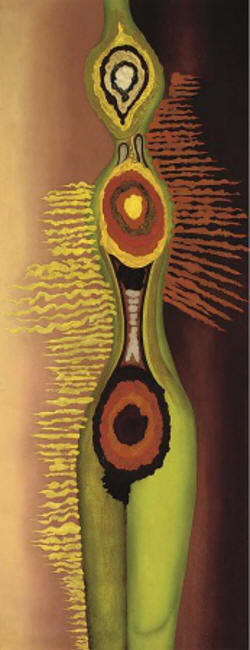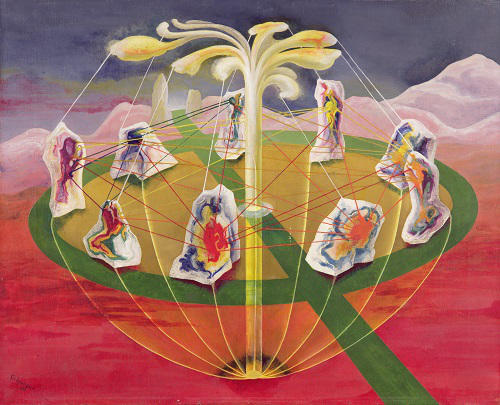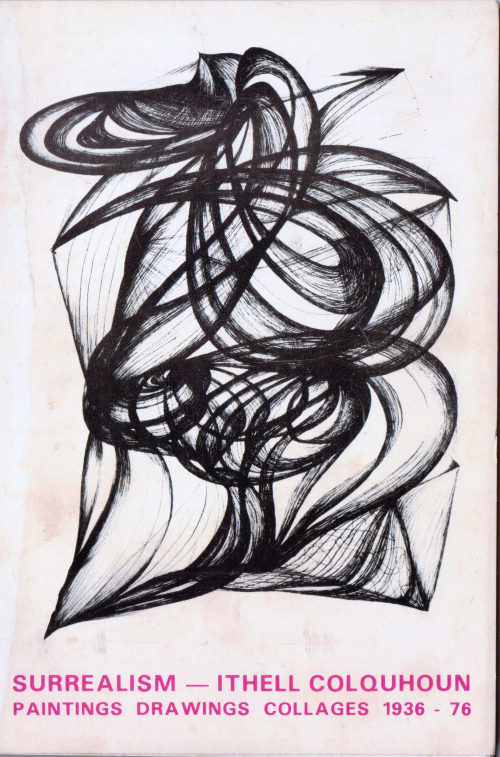|
|
| home | exhibitions | interviews | features | profiles | webprojects | archive |
|
Surrealism Ithell Colquhoun Written for catalogue for solo show at Newlyn Orion Gallery, Newlyn 1976
In the beginning, the Surrealist was a ‘furious Frank’, the Dadaist a ‘fiery Hun’; but Dada arrived before Surrealism. Andre Breton published his first Manifeste du Surrealisme (there were to be others) in 1924 when Kurt Schwitters, Tristan Tzara and other Dadaists had been active for some six years at least. In my development it was the reverse: France influenced me before Central Europe. When I went to live in Paris in 1931 l read a booklet called ‘What is Surrealism’ by Peter Neagoe - an American, I think, of whom I have never subsequently heard. I saw paintings by Salvador Dali in small mixed exhibitions - Dali had not then been excommunicated by Breton. Only in 1936 did the movement make its full impact on me; I had returned to London and was present on July 1st when Dali spoke at the first International Exhibition of Surrealism in Britain in the New Burlington Galleries. Dali, arrayed in a heavy diving-suit (skin diving gear was not yet invented) entered with two wolf-hounds on a leash. He mounted the dais and tried to remove his helmet but it had stuck fast. He was beginning to suffocate when his wife, Gala, (who had once been married to Paul Eluard - also present but soon to quarrel with Breton) sprang up to release him. He gave the speech, Fantomes paranoiaques, authentiques, in French but pronounced it as though it were Spanish. At that time he had little or no competence in English. Andre Breton, robust and thickset with wavy hair of a length at that time conspicious, and others also spoke, but who could follow Dali? It seemed that he did actually evoke phantasmic presences which generated a tense atmosphere; the white cloth stretched to form a lowered ceiling vibrated as in a strong wind, though the weather was still and sultry. Dali was minute, feverish, with bones brittle as a bird's, a mop of dark hair and greenish eyes.
I met Breton in Paris that summer when l visited the studio, 42 Rue Fontaine, where he lived with his first wife Jacqueline Lamba and their daughter Aube then about four years old. The walls were ‘papered' with surrealist art-works, mostly of small size, including cases of tropical butterflies. Breton was interested in a group of painters who were elaborating a surrealist development they called Psychomorphology. This was an effort to tap that level of consciousness sometimes perceptible between sleeping and waking which consists of coloured organic (non-geometric) forms in a state of flux. Their method was little more than an intensification of the automatic processes worked by Max Ernst. l began to use these automatisms in drawing and painting and continued to do so for twenty-five years at least. l was the first to publish an account of them (Enquiry, Oct - Nov. 1949 and Athene, May 1951). I also gave several lecture-demonstrations and l participated in a BBC Television Programme, Fantastic Art, in which l demonstrated three of them. Examples of work based on the automatisms are ‘Autumnal Equinox (picture above right)’ and the ‘Woman of Beare' on the wood - graining of a door, an extension of Frottage; and 'Giantesses undressing to Bathe’ , based on the cracks in a plaster-wall. l made contact again with Breton and met his second wife when he had returned to Paris after the war. A tightly-knit group such as Breton favoured had never obtained in Britain, and the outbreak of World War ll in 1939 had initiated a phase of further dispersal. Early in 1940 a Soho restaurant provided the scene for a meeting of those connected with the movement, or at least, with the London Gallery. These included Ruth Adams, Eileen Agar, John Banting, Robert Baxter, Jacques Brunius, John Buckland-Wright, lthell Colquhoun, Stanley-William Hayter, Charles Howard, Reuben Mednikoff, E.L.T. Mesens, Gordon Onslow-Ford, Dr. Grace Pailthorpe, Roland Penrose, Herbert Read, Edith Rimmington, A.C. Sewter, Sybil Stephenson and Wener von Alvensleben. Humphrey Jennings would certainly have been there if he had been in London but I think he was already abroad on service. Cross-currents of hostility were perceptible from the beginning of the dinner; when it came to the speeches, John Buckland-Wright acted as Chairman and his impartiality provided a necessary calming influence. Attempting to form a closer organisation, Mesens announced about a dozen propositions to which members would be obliged to promise allegiance. The more important and controversial points were:- 1. Adherence to the proletarian revolution. 2. Boycott of any association, professional or other, including any secret society, except the Surrealist group. 3. Boycott of any exhibition or publication except those under surrealist auspices. Each in turn was called upon to express an opinion. Eileen Agar, a member of the London Group, objected to Points 2 and 3; Dr. Pailthorpe and Reuben Mednikoff also objected to Point 3; Herbert Read, as a professional writer, naturally could not agree to it. With the exception of myself, the rest played safe and assented (or pretended to assent) to Mesens’s diktat. On Point 1 I explained that I had always objected to political commitments unsupported by action, and in any case, with war-time conditions no revolutionary action would be tolerated by the authorities. (Ironically enough in view of subsequent events, Brunius had already admitted that this was so, remarking that we were fortunate in that even such a meeting as the present one would be banned in many countries. But he did not draw the obvious conclusions. l further stated that effective revolutionary action was a full-time job and, therefore, irreconcilable with a creative life. On Point 2 I said I wished to be free to continue my studies in occultism as I saw fit. (It was Mesens’s quirk to oppose this aspect of surrealist activity, since Breton, Dominguez, Dr. Mabille, Masson, Seligmann and other continental surrealists pursued such researches without query).
In spite of my commitment both in painting and writing to the surrealist inspiration, I was neither invited to participate in the Surrealism Today Exhibition at the Zwemner Gallery in June 1940, nor to contribute to the special issue of The London Bulletin published in conjunction with the show. (For the record, the ban against me was never authorised by Breton, recognised leader of the surrealist movement, I exhibited at the National Exhibition at the R.A. in 1941. Eileen Agar, apologised to Mesens and was re-instated to favour in time to exhibit, retaining also her membership of other organisations. Ruth Adams, Reuben Mednikoff and Dr. Pailthorpe were deemed expendable. Herbert Read's objection was soon afterwards overlooked, presumably because of his usefulness as a propagandist; he did not sever his connections with the publishing world. An anecdote with a surrealist twist dates from late 1948 when I heard that an exhibition to include a number of surrealist works was planned by the Institute of Contemporary Arts to take place in the Academy Hall, Oxford Street. Thinking that bye-gones could be allowed to be bye-gones, I wrote to Roland Penrose offering to send my 'Autumnal Equinox: a painting eminently suited to '40,000 Years of Modern Art‘. The answer was a curt note of refusal. However, in due course a press-cutting arrived from the Gazzetta Sera (Turin) for Mar. 15/49 which carried a photograph of my picture, under the title Figura Nella Penombra, being carried into the gallery, according to the caption. It also featured the Figure (1926-30), a huge bronze by Jacques Lipchitz, from the l.C.A. show. In fact I had a few weeks later submitted my work to a different exhibition; but some journalist must have felt obscurely that its totem-like forms would figure more appropriately among the Art of our Time exhibits at the Academy Hall. Objective Hazard redresses the balance! In the early 1960's, I became intrigued with the visual and tactile qualities of the ‘ready-made’, first exploited by Marcel Duchamp. But in my case it was the ‘ready throw-away’ which inspired me. I saw a valid, if silent, statement in what is usually discarded. This fascination produced the Merz - reliefs, also the collages, with which I had experimented since 1942 (Newlyn Gallery 1967 and 1971). I had met Schwitters in Hampstead where he stayed from time to time during the 1939-45 war as a refugee in this country. I contributed a note, Kurt Schwitters en Angleterre, to Fantasmagie (Bruxelles) No. 29, Feb 1971, and an Apergu sur l’Origine du Collage to its No. 31 in December of the same year. Since 1959 I had been exhibiting with Aubin Pasque's Fantas- magie group exhibitions all over Europe, notably in Czechoslavakia just before the 1968 coup.
Surrealism was always fond of lists; in other words, it favoured the aphoristic mode. ln such lists one may find the genesis of many subsequent ‘list-poems’. l choose from a long list of Pre-Surrealists compiled by André Breton a few names, those which will be most familiar to the English-speaking world: ‘Dante is surrealist and Shakespeare in his better days. Young's ‘Night Thoughts‘ is surrealist from start to finish; unfortunately it is a priest speaking, a bad priest no doubt, but a priest. Heraclitus is surrealist in dialectic. Lulli1 is surrealist in definition. Flamel2 is surrealist in the night of gold. Swift is surrealist in malice. Sade is surrealist in sadism. Lewis3‘ is surrealist in the beauty of evil. Carrol is surrealist in nonsense. 1 Ramon Llul, the alchemist 2 Nicholas Flamel, the alchemist. 3 Author ofThe Monk (‘Monk Lewis‘) Picasso is surrealist in cubism. Poe is surrealist in adventure. Jarry is surrealist in absinthe. Nouveau is surrealist in the Kiss. Still more amusing is the list complied by the Pre-Surrealist Isidore Ducasse thumb-nail sketches caricaturing the Romantics, the Great Fat-heads, as he called them: ‘Chateaubriand, the melancholy Mohican; Senancourt, the Man in Petticoats; Jean - Jacques Rousseau, the socialistic cross-patch; Ann Radcliffe, the dotty ghost; Edgar Poe, exotic horseman of the alcholic stupour; Georges Sand, the circumcised hermaphrodite; Byron, hippopotamus of the jungles of Hell.’ Surrealism has been called the tail-end of the Romantic Movement - ‘a very'prehensile tail’, as Breton quipped.
Ithell Colquhoun January 1976.
|
|
|


 To
Point 3 I also objected because it meant not exhibiting or publishing at
all, since there was then no surrealist gallery or publication in
Britain, and those abroad were barred by war-time conditions. (The
London Gallery closed in 1939 and did not re-open until 1946). As I was
leaving the restaurant Mesens came up to me saying, ‘Whatever happens l
am your friend!’ I never knew exactly what he meant, but I thought I had
cooked my goose.
To
Point 3 I also objected because it meant not exhibiting or publishing at
all, since there was then no surrealist gallery or publication in
Britain, and those abroad were barred by war-time conditions. (The
London Gallery closed in 1939 and did not re-open until 1946). As I was
leaving the restaurant Mesens came up to me saying, ‘Whatever happens l
am your friend!’ I never knew exactly what he meant, but I thought I had
cooked my goose. From
the middle 1960's l have used enamel paint, more or less diluted, in a
semi-automatic way to bring about the emergence of what Breton called
the ‘Convulsive Landscape’. Living in Cornwall has suggested this, among
much else. More recently I have come to see-hear the
Psycho-morphological implications in music; this too is a natural
development for me: I refer to the large gouache of 1946, Linked Senses.
From
the middle 1960's l have used enamel paint, more or less diluted, in a
semi-automatic way to bring about the emergence of what Breton called
the ‘Convulsive Landscape’. Living in Cornwall has suggested this, among
much else. More recently I have come to see-hear the
Psycho-morphological implications in music; this too is a natural
development for me: I refer to the large gouache of 1946, Linked Senses.